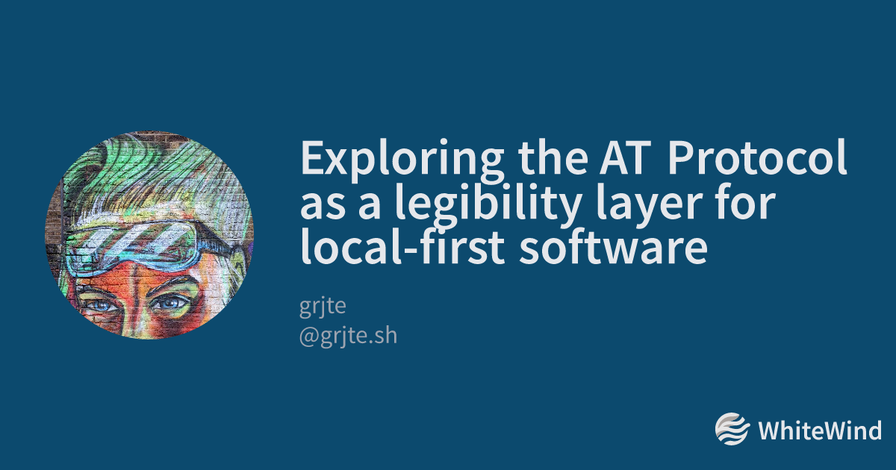Exploring the AT Protocol as a legibility layer for local-first software (Groundmist post 2)

my notes ( ? )
Grjte's 2nd Groundmist post "to explore ... local-first AppViews for local-first data, similar to atproto's AppViews for public data" first points out that the protocol allows anyone "to build a wide variety of different views ... of public ... Personal Data Servers (PDSes). These interfaces are known as "AppViews" ... provide just one of many possible views of the" data in the PDS. Moreover, "AppViews [can] compose data from multiple application sources".
So she decided to build an Appview of private "local-first" data, creating "a local-first markdown editor that uses a public lexicon to define the document schema" that can "publish documents to your atproto PDS" when you want to move something from private to public. She also created "a public AppView for reading the published documents", and notes that these "local-first markdown files could be edited in any other AppView that uses the same lexicon".
Lexicon explainer
She then gives a good explanation of what Lexicons are and do, with examples:
- "specifies a schema definition language alongside usage and publishing guidelines...
- schema definition language provides a way to agree on semantics and behaviours and makes it simple for developers to introduce new schemas or safely reuse existing ones.
- Lexicons are JSON files associated with a single namespace identifier (NSID), such as app.bsky.feed.post.
- NSIDs are used for organizing data within the PDS or retrieving data from collections, which are identified by the NSID...
- structured guidelines for how Lexicons should be published and resolved ... creates a global network of accessible and discoverable schematic information."
All of this brings "3 major benefits:
- Interfaces independent of servers...
- AppViews only need to know the data and the Lexicon ...
- applications don't need separate data store ... Creating and publishing these interfaces can be extremely fast and lightweight."
What about AI?
Does "structured data still has value in a world of LLMs and sophisticated AI agents"? Yes:
- "Clear and consistent rules for understanding data semantics and structure make it easier for agents ... better results with less compute". According to Comind in using lexicons with AI, if "every language model will produce content in a pre-specified format, then everyone on the comind network is capable of hooking into any output from the network"
- If we want our AI to "modify our underlying data, reusing and changing it in different contexts ... we need some way for our agents and applications to coordinate". While different apps reusing data usually results in two similar-but-not-identical datasets, running on two separate applications, "AT Protocol's design enables data reuse without this sort of duplication... Every record has a single source of truth and is accompanied by the rules for how to interact with it".
- This coherence is lost when an AI comes along, reads a PDS and writes something somewhere else. The schema system allows us to manage an AI writing back onto the canonical location (PDS), avoiding this fragmentation while ensuring the data remains "valid and legible", and that we can"still understand, access, and analyse the output" to have some degree of control over AI-created products (cf Andy Matuschak's recent post).
Building a local-first "AppView"
He introduces Whitewind, pointing out that as all PDS data is public, it's 'visibility' field is wishful thinking: "The hope is that all AppViews will respect this field and that no person (or AI) will query and look at data where "visibility" isn't "public"... We can't realistically expect compliance".
Hence "Groundmist Editor, a simple local-first writing tool for drafting and collaborating on markdown documents and then publishing them when ready. It uses the WhiteWind blog entry lexicon... [so] WhiteWind acts as a public AppView for published entries". She also built "an alternative AppView for viewing published writing called Groundmist Notebook"), and added a sync server to Groundmist Editor to share content between different devices.
Another model?
While groundmist is basically what I'm looking for fr MyHub, she also foresees a different model: local-first, Lexicon-based apps working together on content "that never gets published ... the dream of collaboration over a data set without being required to use the same application or interaction mode".
She uses the example of preferring Obsidian for some writing/note-taking tasks, and Logseq for others, and would "like ... custom personal interfaces for interacting with different types of writing and notes, while still keeping it in a unified home and having a single application that knows how to interact with all of it at once".
However, she concedes, "strictly using Lexicon for defining local-first data will inevitably be too restrictive in some cases", so data lenses might help - see Ink & Switch's Cambria, and now "the community has recently begun to work on" 'Lexicon Lenses'.
Read the Full Post
The above notes were curated from the full post whtwnd.com/grjte.sh/3lndyhyvqdc2w.Related reading
More Stuff I Like
More Stuff tagged atprotocol , groundmist , ai4communities , grjte , atprotocol lexicon , ai , whitewind
See also: Bluesky and the ATmosphere , Digital Transformation , Innovation Strategy , Science&Technology